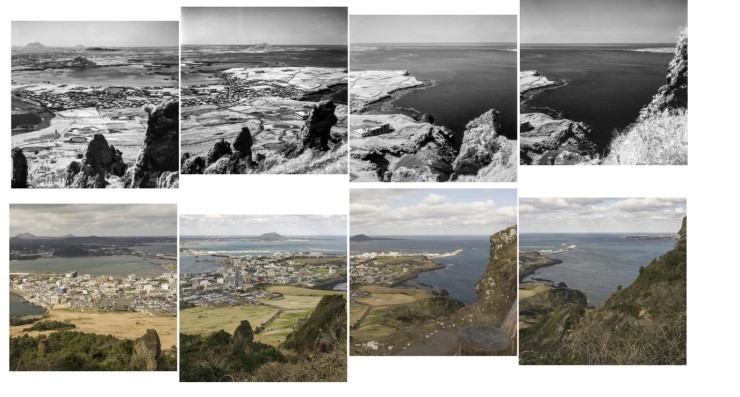|
The photos of Seongsan Ilchulbong Peak by my father Koh Young-il, probably taken in the 1960s, have their own distinct style. My father took them from the top of the peak looking out toward the village. I want to talk about these photos.
When I first saw my father’s pictures of Seongsan Ilchulbong Peak, I thought each cut had a different landscape. But after scanning them and seeing them on the monitor, I realized that these black and white photos were connected to one another. The first one was taken from the peak toward the village and was followed by photos of Udo, Seongsanpo Port, Seongsan-ri village overview, and the alcove beach in Ojo-ri. These photos were all taken in sequence and formed a panorama shot. The photos were taken in the 1960s with a film camera, starting from the right and moving over to the left. It was intriguing. Did my father take each photo without limitations on the angle so that he could re-connect them when he was printing? Did they even have the word “panorama shot” in the 1960s?
I wonder how he even thought of taking a panorama shot of the Seongsanhang Port and the village on top of the Peak. I’m very curious but there’s no way to receive the answer. I can only guess that he probably wished to capture the entire landscape that cannot be grasped from just one photo.
Does it look like a panorama shot? The black and white photos are my father’s, and the color photos underneath are mine. I closely tuned the angles of my shots to those of my father's and connected them like a panorama shot to compare them.
On the right, the first pictures show Udo and the Seongsanhang Port. As the port grew in size, you can see how the breakwater expanded.
In the second set of photos, the Seongsanhang Port area that used to be a farming field is now filled with houses, and the hotel on the bottom was demolished.
Comparing the third photos, you can see Jimibong Peak in the distance, and the inland bridge that has been built between Seongsan-ri and Ojo-ri. The breakwater at Seongsanhang Port, which used to be only on the east side, is now on both the east and the west side. The village went through a lot of changes: the houses, the restaurants, the hotels, the cafes, and the supermarkets all turned into tourist-serving venues. You can no longer enjoy the old village vibes.
When my father took these panorama shots in the 1960s, overcoming the limitations of the angle of view, I wonder if he intended to record Seongsan-ri area at the time.
If such photos did not exist from back then, we couldn’t compare them to photos of now. Gathering them together and comparing them with today’s scenery in one view was such an exciting and interesting job. We were able to come up with this project thanks to these shots.
Can you see how it has changed?
Koh Young-il (1926-2009)
Born in Jeju in 1926, he graduated from Mokpo Industrial High School and Seoul Hyehwa Vocational School. In the post-liberation period, he was an active journalist in Jeju, working as the editor for Jeju Press and as a war correspondent during the Korean War. Koh experienced the turbulent period of Korea, especially Jeju’s history.
Starting with a collaborative exhibition with Bu Jong-hyu in 1955, he held six individual exhibitions between 1957 and 1998. During this time, he was a founding member who established the Association of Jeju Photographers in 1959, Jeju Camera Club in 1965, and the Jeju branch of Photo Artists Society of Korea in 1977. After 1977, he worked as an administrative staff in the academic review department at the Photo Artists Society of Korea and continued his life as a photographer. In the 1960-70s, he left more than 20,000 photos of Jeju Island on film. His photo books include “Jeju in the 1960s” (1997) and a posthumous memorial photo book, “Jeju Underneath”(2011).
Koh Kyung-dae(1958- )
Born in Jeju, he resides in Pyeongdae-ri, Gujwa-eup, in the city of Jeju. He takes photos of the places in Jeju where his father Koh Young-il had previously photographed in the 1960 and 70s. The project is titled, In Koh Young-il’s Footsteps. Koh Kyung-dae’s hidden agenda is to illustrate that Koh Young-il photos are not mere lifeless records of the past, but what embodied each moment’s sentiment in the most familiar and animated ways. |




















